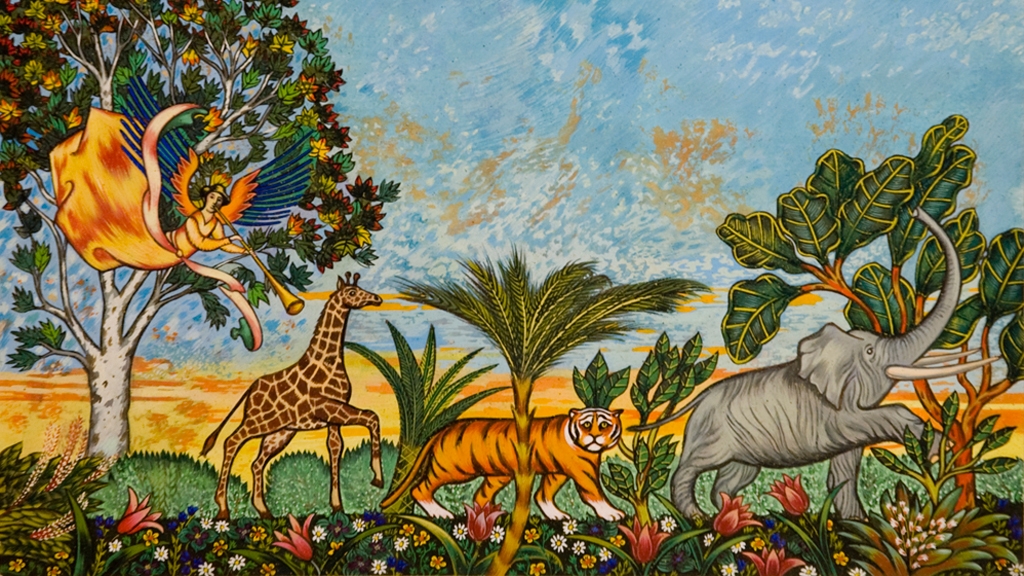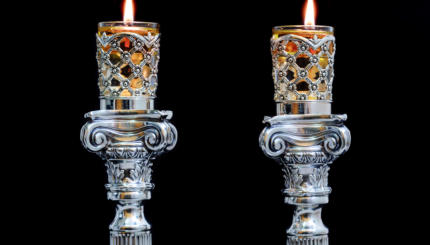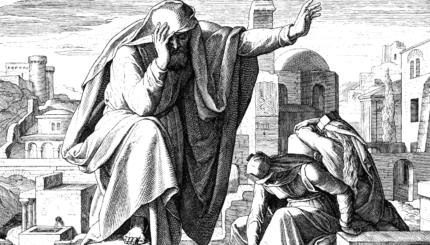The Mishnah teaches that Tu Bishvat is the new year for the trees. By Tu Bishvat, the majority of the winter rains have already fallen, sap is rising, and new fruits are beginning to form. Therefore, when it comes to mitzvot such as orlah (fruits prohibited in the first three years of a tree’s production), Tu Bishvat distinguishes between the last year’s fruits and the fruits of a new year.
That Tu Bishvat has come to be associated with sensitivity to and appreciation of the natural environment is not by chance. Trees occupy a special place in Jewish thought, which closely relates to man’s relationship with the natural environment, our life-support system.
Trees in the Midrash
For example, the Midrash in Kohelet Rabbah teaches: “When God created the first man he took him and showed him all the trees of the Garden of Eden and said to him, ‘See my works, how beautiful and praiseworthy they are. And everything that I created, I created it for you. Be careful not to spoil or destroy my world–for if you do, there will be nobody after you to repair it.'”
This Midrash singles out the trees of the Garden of Eden–rather than the Garden of Eden itself–to represent the natural world, the work of the Creator. Why should trees be chosen to symbolize the natural world?
Trees are at the pinnacle of the plant world, which transforms the earth from a barren and lifeless mass into an environment capable of supporting other forms of life such as animals and humans. We find this expressed in the Midrash Sifrei: “[the phrase] ‘because a man is a tree of the field’ teaches that the life of man is from the tree.” (Piska 203)
Likewise, Rabbenu Bahya, a medieval Jewish philosopher, writes: “The commentators explain that the life of man and his food is [from] a tree of the field…and it is not the way of a wise and understanding nation to needlessly destroy something so worthy, and therefore you should not cut down a tree of the field, rather you should protect it from destruction and damage, and take benefit from it.”
A Special Blessing
The Me’Am Loez (an 18th and 19th century Bible commentator) writes: “Man’s life is dependent on trees, and the tree is so important for the existence of the world that the sages established a special blessing for those who go out in [the Hebrew month of] Nisan and see blossoming fruit-producing trees. [The blessing says] ‘nothing is lacking from His world and He created good creations and good trees for the benefit of man.'”
It is important to note that in the Jewish liturgy there is no comparable blessing–uniquely singled out for one of the natural wonders of creation that provide benefit to man. This despite the fact that there are other important aspects of the natural world, which might be considered at least as crucial to man, such as the rainfall or the harvesting of crops.
God as Horticulturalist
The Midrash in Vayikra Rabbah stresses the importance–during times of major transition, such as the creation of the world and the entrance of the Jewish people into the land of Israel–of first preparing the necessary life-support system, expressed as trees: “It is said, ‘follow the Lord, your God.’ This means follow His example. When He created the world, His first action was to plant trees, as it written, ‘and God planted a garden [of trees] in Eden.’ So you, too, when you will enter the land of Israel, planting trees should be your first involvement.”
A Lesson in Sustainability
Parenthetically, it might be suggested that–as a symbol of the life-support system for man–trees also play an important educational role in the Jewish sources. Originally, the sources tell us, trees were meant to be entirely edible, with the trunk and branches tasting like fruit. Since trees were meant to be the main source of food for man, the entire tree could be consumed for immediate benefit. Consuming the entire tree, however, would destroy its productive capacity. Alternatively, the tree could be left intact to produce edible fruits which could be continuously consumed without destroying the tree itself (Rashi, Midrash Bereishit Rabbah).
This teaching points to the need to forego the destructive exploitation of natural resources for immediate, short-term benefit, in favor of preserving the productive capacity of resources–to allow the sustained utilization of their fruits. This important ecological principle is known today as sustainability.
The above texts demonstrate the vital importance Jewish sources place on trees as representative of the life-support system for man, and on the management of their long-term viability.
Yishuv Ha’aretz: Settling the Land
On a more practical level, trees are also given great importance in the mitzvah of yishuv ha’aretz–settling the land of Israel.
The mitzvah of yishuv ha’aretz requires us to develop the natural world to provide for our needs, including a suitable place to live, work, learn, and serve the Creator, and also to develop appropriate systems for the supply of food, energy, water, and transportation needs. This must be in balance with other considerations including the ecological integrity of the land.
For example, according to Jewish law, someone selling land in Israel must give first consideration to any neighbor whose land abuts the parcel of land being sold. If, however, the neighbor wants to use the land for a purpose which will contribute less to yishuv ha’aretz than other buyers would, he loses this privilege and the land can be sold to another buyer.
According to the Shulhan Arukh (16th century legal code): “If someone wants to buy a parcel of land to build houses, and the ben maitzra [neighbor with land abutting the land being sold] wants to buy the same parcel of land to plant crops, the buyer [who wants to build houses] has first right because of yishuv ha’aretz, and the rule of ben maitzra doesn’t apply. Some say, if the ben maitzra wants to plant trees, he takes precedence over the other buyer.”(Hoshen Mishpat, 175:21)
A commentator to the Shulhan Arukh, the Sm’ah, explains: “That which is more permanent on the land better fulfills [the mitzvah of] yishuv ha’aretz. Houses are more permanent than crops, and trees are more permanent and rooted in the land than houses.”
Fruit-Producing Trees
The protection of fruit-producing trees was given even greater status. The Mishnah in Tractate Tamid teaches: “It is forbidden to bring wood from olive trees or grape vines [and some say also, wood from fig trees and date palms] to the [Temple] altar because of [the mitzvah of] yishuv Eretz Yisrael.”
Aside from the benefits olive trees and grape vines provide, the commentaries explain that wood from these trees produces excessive smoke (air pollution), which would also reduce the quality of life and detract from yishuv ha’aretz.
The Talmud in Bava Metzia stresses the importance of olive trees in the observance of yishuv ha’aretz:
If a [flooding] river washes away an olive tree and plants it in a neighboring field, and the owner of the tree wants to uproot the tree and replant it in his field, in the land of Israel we don’t allow him, because of yishuv Eretz Yisrael.
The purpose for this ruling is to increase the number of olive trees in the land of Israel. The rabbis understood that the original owner, upon losing the tree, would be likely to plant another to replace the one that was washed away. The owner of the land upon which the tree was replanted (by the river), who had not invested time or effort in the tree, would be less likely to bother to plant another olive tree if the original owner were to reclaim his tree.
Beyond Israel
Finally, lest we think that yishuv ha’aretz only has relevance to the settlement of the land of Israel, Rabbi Samson Raphael Hirsch writes that the settlement of the Jewish people in the land of Israel is meant to be a model for the rest of the world.
Hirsch writes: “Man was created outside Paradise, and he was destined, already here below, to live in a ParadiseWe are shown what we should be, how we should live, how the world of ours would form a Paradise for us, if we would be that which we should be. A similar lesson was to be repeated, on a reduced scale for a small sample, chosen as an example for the whole human race in Eretz Yisrael–which was also to be a Gan Eden for the people of Creator’s law. It was meant to show the world, a second time, by its prosperity and its progress, what an abundance of blessing and happiness would be attained here on earth when the will of the Creator is taken as the sole measure for arranging all phases of human life.
Tu Bishvat gives us an opportunity to refocus on God’s creation and to increase our appreciation for the good land and good trees He provides for us. In this way, we can be a positive example for the rest of the world.
Reprinted with permission of Canfei Nesharim.
Midrash
Pronounced: MIDD-rash, Origin: Hebrew, the process of interpretation by which the rabbis filled in “gaps” found in the Torah.
mitzvah
Pronounced: MITZ-vuh or meetz-VAH, Origin: Hebrew, commandment, also used to mean good deed.
Nisan
Pronounced: nee-SAHN, Origin: Hebrew, Jewish month, usually coinciding with March-April.
Talmud
Pronounced: TALL-mud, Origin: Hebrew, the set of teachings and commentaries on the Torah that form the basis for Jewish law. Comprised of the Mishnah and the Gemara, it contains the opinions of thousands of rabbis from different periods in Jewish history.
Tu Bishvat
Pronounced: too bish-VAHT (oo as in boot), Origin: Hebrew, literally “the 15th of Shevat,” the Jewish month that usually falls in January or February, this is a holiday celebrating the “new year of the trees.”



